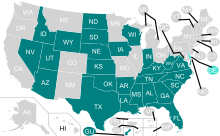Right-to-work law
As a right-to-work law in are the United States , various laws referred to a power limitation of trade unions have the aim. Among other things, this is intended to prevent employment relationships that require union membership ( closed shop ), as well as requirements for employees to pay union fees in order to benefit from collectively negotiated benefits ( free rider problem ).
The translated German term right to work is misleading in this context, as right-to-work laws are not a legal guarantee for a job. Instead, the term alludes to the individual worker's right to appear at work without prejudice, even if, for example, a union calls a strike .
Although the Taft-Hartley Act of 1947 provides a corresponding regulation at the US federal level, right-to-work laws are particularly important in many states . Right-to-work laws are extremely controversial in the US; They are discussed controversially both in politics and in public.
Scope of application
Federal level
The best-known legal regulation at the federal level is the Taft-Hartley Act , whose official name is the Labor-Management Relations Act . This law was passed by Congress in 1947 , which at the time was Republican dominated. Since a number of Democratic MPs also approved, the veto of Democratic President Harry S. Truman was overruled by a two-thirds majority.
The Taft-Hartley Act gives unions some rights, but essentially limits their ability to act. In particular, the law forbade the practice of the “ closed shop ”, according to which a company may only employ members of a certain union, so that non-members were de facto excluded from certain jobs. An “unfair trade union practice” - a formulation that leaves a lot of room for interpretation - has been banned by law. The trade unions were also banned from political activity. Likewise, the law forced union leaders to confirm that they were not communists . Under this law, the President was allowed to have strikes - if they could endanger a national interest - for the purpose of calming down for a period of 80 days.
States
25 of the 50 US states currently have right-to-work laws. In seven states these are even enshrined in the constitution , in Nebraska twice: both in the constitution and in a simple law.
Right-to-work laws prohibit unions from charging compulsory membership fees, thus abolishing compulsory fees. These laws also do not allow applicants to be rejected for jobs who are not unionized. The “right to work” laws lead to a noticeable decline in the income of employee representatives, which, according to the union, also has the effect that higher wages and better working conditions for its members can be negotiated less efficiently.
Right-to-work laws come almost exclusively from Republican governors and members of parliament , while Democratic Party politicians mostly reject such laws. In spring 2011, for example, both dominated by Republicans chambers of parliament approved the state of New Hampshire a right-to-work law, which the Democratic governor John Lynch with a veto stopped. An attempt to outvote failed. In Ohio , a corresponding law was overturned by a referendum in November 2011 after the opponents of right-to-work had collected enough signatures for such a poll.
States with right-to-work laws are:
|
|
Debate and Criticism
Right-to-work laws are usually the subject of sharp political controversy and have a polarizing effect on the public. Opponents of right-to-work argue that it is a matter of pushing back unions by weakening them financially. This is automatically linked to restrictions on employee rights, whereas these regulations result in more opportunities to enforce the interests of the employer . Proponents of “right-to-work” laws, however, argue that every worker should have the right to choose whether or not to join a union. In addition, compulsory fees to trade unions would make it more difficult to create new jobs and thus economic growth .
In January 2012, a nationwide poll found that 74 percent of US citizens are in favor of right-to-work laws. During the parliamentary deliberations in Michigan in 2013 a more mixed picture emerged: In a survey, 43 percent of citizens said that a corresponding law would be useful for the economy, while 41 percent believed that it would do more harm than good. Ohio is the only state that has been able to overturn such a law by referendum.
Individual evidence
- ↑ Melvyn Dubofsky (Ed.): The Oxford Encyclopedia of American Business, Labor, and Economic History. Oxford 2013, ISBN 978-0-19-999304-8 , pp. 125f.
- ^ How Many Democrats Voted for Taft-Hartley .
- ↑ a b US Republicans Fight Trade Unions: Declaration of War in the Rust Belt. In: Süddeutsche Zeitung . January 31, 2012.
- ↑ a b Right to Work Laws in the USA: Protesters demand: "Kill the Bill". In: Frankfurter Rundschau . December 13, 2012.
- ↑ Lynch vetoes "right to work" bill. In: New Hampshire Union Leader. May 11, 2011
- ^ Right to work states
- ↑ 74% Favor Right-to-Work Law Eliminating Mandatory Union Dues , Rasmussen Reports, January 31, 2014 (English)
- ↑ Poll: Michigan evenly divided on right-to work law , MLive, March 31, 2013 (English)
